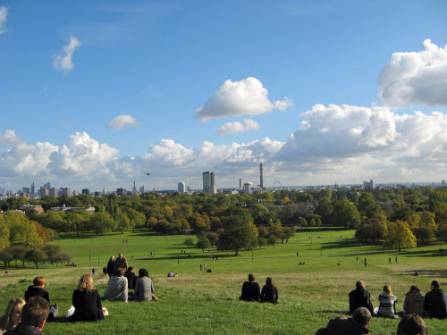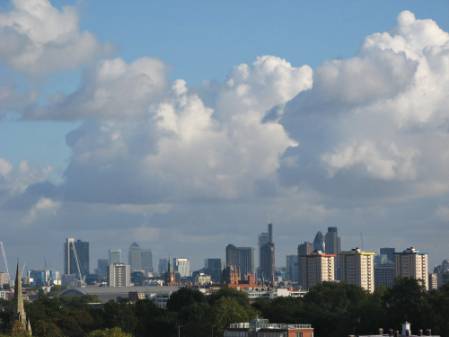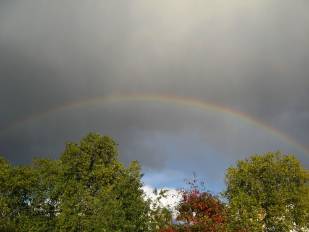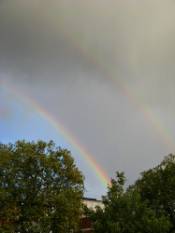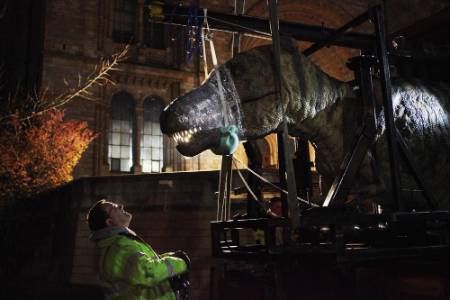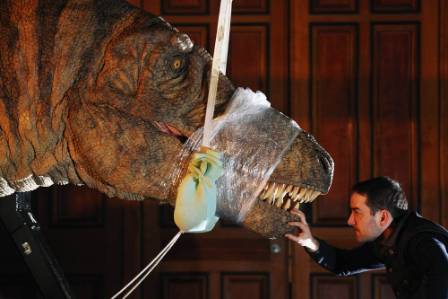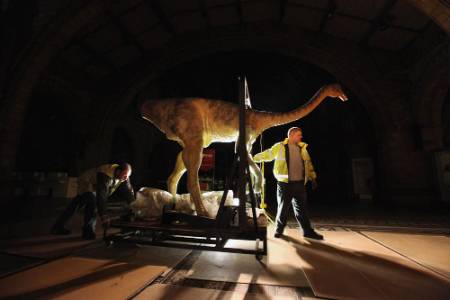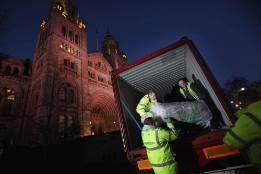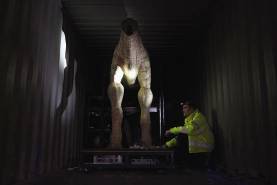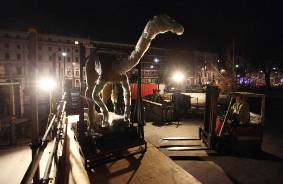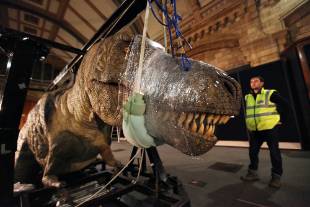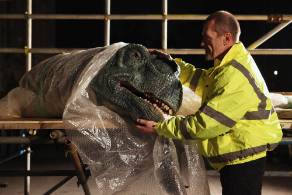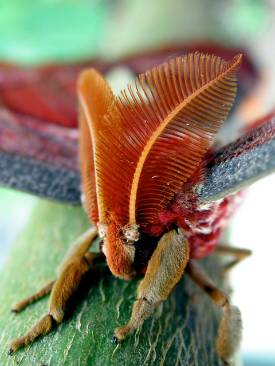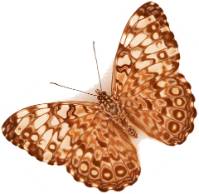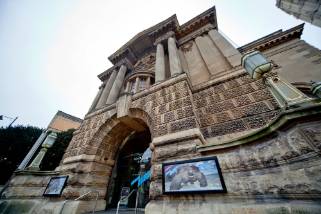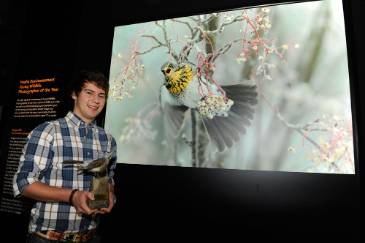There was a moment on Monday night, at the author's book launch event here, when I actually expected a Neanderthal to walk onto the stage and join novelist Jean M Auel and Museum scientist Chris Stringer in their conversation about prehistoric life and the Earth's Children books.
Both modern humans entertained us for an hour chatting about the wonders of cave art and craft, Neanderthal veggies, the interbreeding of Neanderthals and early humans, and the possiblity of cloning Neanderthals in the future.
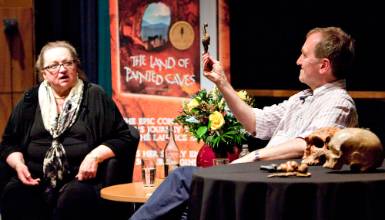
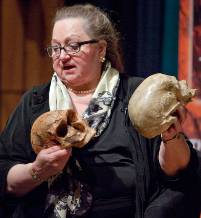
Left: Novelist Jean M Auel and Museum palaeoanthropologist Chris Stringer admire a Venus statuette as an example of early cave art at the author's book launch event on 28 February in the Museum's Flett Theatre. Right, Jean compares a Neanderthal skull with an early human one. The Land of Painted Caves is out on 29 March.
The age-defying, 75-year-old American novelist arrived with several family members and various literary and publishing aides, to find a packed Flett Theatre in the Museum. Chris Stringer brought some rare, prehistoric objects and remains. The event marked a step closer to the long-awaited release of Jean’s sixth and final book, The Land of Painted Caves, in her bestselling Earth’s Children series. The series follows the epic adventures of Ayla, an early modern human girl adopted by Neanderthals, growing up and adapting in Ice Age Europe.
Stepping back about 30,000 years, it was fascinating to hear the two speakers talk about the similarities and differences between Neanderthals and Cro-Magnons (early modern humans) who populate Jean’s books. And to discover the comparative views of a bestselling novelist and renowned palaeoanthropologist on the advances in our understanding of these species. The conversation wasn't so much fact versus fiction, more fact enriching fiction.
It was clear that Chris and Jean were equally intrigued by the Neanderthal race. And I discovered how close we all really are when Chris pointed out that recent research shows that most of us in the audience would have about two and half per cent Neanderthal DNA in our genes.
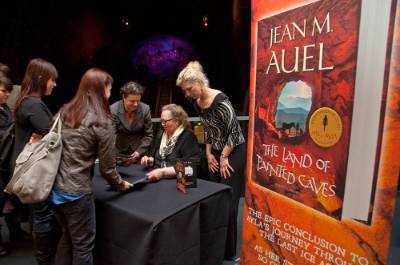
Jean told us how she researches her books, visiting caves and conferences, learning how to make snow fires and stone tools, and even treat deer buckskins with brains! Chris drew attention to the historic detail in her books of animals, objects and the Ice Age landscape.
So what was the inspiration for the Earth’s Children epic? ‘It started out as a short story. But I quickly found I only “do long”,’ joked Jean. ‘What if we were sharing this world with another kind of human? That was my original thought, which sparked the idea.’
The author didn’t give away much about the content of The Land of Painted Caves, except to mention that all but one of the caves in the final book are based on real caves, many of these she has visited. ‘Life got in the way,’ was her answer to the questions of why the long gap since her last book and why the series has taken 30 years to complete.
We were enlightened further when the speakers answered questions from fans, like, ‘Where did Ayla’s name come from?’ ‘Is Ayla a feminist character?’ 'What inspired the memories and sign language of the Neanderthals in your story? ‘How did you get your first book published?’ 'Is it true Neanderthals had rickets?’ And ‘What is the scientific evidence of interbreeding between humans and other species?’
But you’ll have to wait to watch the film of the event to find out some of the answers. We will have a short video clip on our website soon. And there will be more film coverage on the publisher's website. Our event was followed by an author's signing session (pictured above).
The Land of Painted Caves is published on 29 March by Hodder & Stoughton. Their Jean M Auel website has all the details.

You can get a limited edition of the new book featuring an AR (augmented reality) Ayla showing what she might have looked like. Some of Jean’s fans helped decide on this here earlier on in the author's visit to the Museum.
In the meantime get to know Neanderthal man more closely in our latest Neanderthal factfile animation (left) and if you have a webcam you can have an augmented reality Neanderthal in your home.
Come and find out more from Chris Stringer at our free talk on 11 March at 14.30: Are we Neanderthals?
Read my earlier blog about the Jean M Auel in Conversation event
Find out more about human evolution and the ancient human occupation of Britain
See a 14,700-year-old human skull cup replica on display at the Musem
Compare 3D hominid skulls in our online interactive
Enjoy more pictures from the event. Select them to enlarge
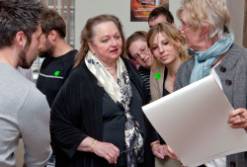
Jean Auel meets fans here to help choose the augmented reality image of her books' heroine, Ayla

Sharon Ament, the Museum's Public Engagement Group director intoduces Jean Auel and Chris Stringer in the Flett Theatre
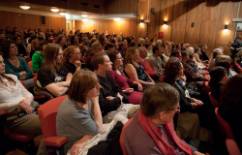
A captivated audience in the packed Flett Theatre

Chris Stringer shows a rare, ritualistic 14,700-year-old human skull-cup replica, now on public display here

The author gets ready to sign books for her fans

A happy fan gets the first book, The Clan of the Cave Bear, signed



